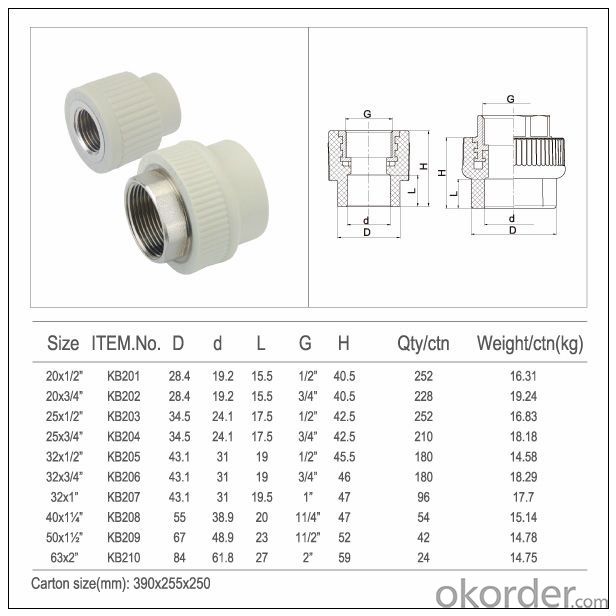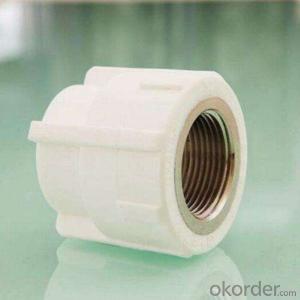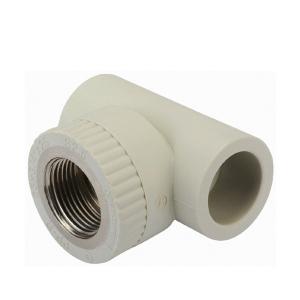Copper Pipe Into Plastic Fitting - 2024 New PPR Coupling for Industrial and Agricultural Fields
- Loading Port:
- Dalian
- Payment Terms:
- TT OR LC
- Min Order Qty:
- 1000 pc
- Supply Capability:
- 1000000 pc/month
OKorder Service Pledge
OKorder Financial Service
You Might Also Like
Product Overview
1) Cold / hot water supply facilities for public buildings
2) Food, chemical, electronic industry pipeline networks; Such as Pipeline networks for transporting all kinds of corrosive liquids
3) Drinking water production system pipeline networks; Such as Pure water and mineral water
4) Air conditioning facility pipelines
5) Compressed gas pipeline networks for industry
6) Pipeline networks for swimming pools
7) Pipeline networks for solar energy facilities
8) Agriculture and garden production transporting systems
Company Information
CNBM International Corporation (CNBM International) is the most important trading platform of CNBM Group Corporation, a state-owned company under the direct supervision of State-owned Assets Supervision and Administration Commission of the State Council.
CNBM International is highly recognized by its business partners and clients all over the world and has obtained rapid development under the spirit of win-win. We will carry on the mutual beneficial, innovative and revolutionary trading structure as we did before, create value for our employees, share holders and clients and benefit the whole society in our future development.
Product Description


Product Show



Why choose us?
(1) Professional factory: We are manufacturer, specializing in manufacturing multilayer PP-R, PE pipe and PP-R, PE pipe fittings for more than13 years, our price is competitive with high quality. And we can delivery product in quick way.
(2) Sample: We can send samples out in 3 days, but the express charge usually paid by your side, but the fee will be rebound when we have formal order.
(3) Rapid response to your needs: We will be answer within 24 hours. Welcome to contact with us if you have any problems. We are looking to cooperating with you.
(4) We hope we can establish long-term and mutual benefit business relation with you. If you have any problem, please kindly feel free to contact me. I will try the best to help you!
- Q: Can plastic pipe fittings be used for swimming pool systems?
- Yes, plastic pipe fittings can be used for swimming pool systems. Plastic fittings are commonly used in pool systems due to their durability, resistance to corrosion and chemicals, and ease of installation. They are available in various sizes and types, such as PVC or CPVC fittings, which can effectively handle the water flow and pressure requirements of a swimming pool system.
- Q: Can plastic pipe fittings be used for drinking water systems?
- Yes, plastic pipe fittings can be used for drinking water systems. However, it is important to ensure that the fittings are made from materials approved for potable water applications and meet the necessary standards and regulations to ensure the safety of the drinking water.
- Q: Can plastic pipe fittings be used in radiant floor heating systems?
- Yes, plastic pipe fittings can be used in radiant floor heating systems. Plastic fittings are commonly used in these systems due to their durability, resistance to corrosion, and ease of installation. Additionally, plastic fittings are often less expensive than other materials, making them a cost-effective choice for radiant floor heating systems.
- Q: Can plastic pipe fittings be used in desalination systems?
- Yes, plastic pipe fittings can be used in desalination systems. Plastic materials such as PVC, CPVC, and polypropylene are commonly used in desalination plants due to their corrosion resistance, durability, and cost-effectiveness. These plastic pipe fittings are suitable for transporting and distributing seawater, brine, and other chemicals used in the desalination process.
- Q: Can plastic pipe fittings be used in culvert systems?
- Yes, plastic pipe fittings can be used in culvert systems. Plastic pipe fittings are commonly used as they are lightweight, resistant to corrosion, and easy to install. They can effectively connect and redirect the flow of water in culvert systems, making them a suitable choice for various applications.
- Q: What are the common testing methods for plastic pipe fittings?
- Some common testing methods for plastic pipe fittings include pressure testing, leak testing, visual inspection, dimensional verification, and material analysis.
- Q: Are plastic pipe fittings resistant to impact and pressure?
- Yes, plastic pipe fittings are generally resistant to impact and pressure. They are designed to withstand high levels of pressure and are durable enough to resist impact or external forces that may be applied to them.
- Q: Can plastic pipe fittings be used for water supply in remote areas?
- Yes, plastic pipe fittings can be used for water supply in remote areas. They are lightweight, durable, and resistant to corrosion, making them suitable for long-distance transportation. Additionally, plastic fittings are easy to install and maintain, which is beneficial in remote locations where resources may be limited.
- Q: Can plastic pipe fittings be used with both PVC and CPVC pipes?
- Yes, plastic pipe fittings can be used with both PVC (Polyvinyl Chloride) and CPVC (Chlorinated Polyvinyl Chloride) pipes.
- Q: What's the size of the PPR pipe?
- (1) PP-R piping shall be standardized according to specifications.(2) hot melt connection: for pipes whose outer diameter is less than 63mm, the hand welding machine is used for connecting; for the pipe with outer diameter greater than 63mm, the high power welding device is used to connect.
Send your message to us
Copper Pipe Into Plastic Fitting - 2024 New PPR Coupling for Industrial and Agricultural Fields
- Loading Port:
- Dalian
- Payment Terms:
- TT OR LC
- Min Order Qty:
- 1000 pc
- Supply Capability:
- 1000000 pc/month
OKorder Service Pledge
OKorder Financial Service
Similar products
Hot products
Hot Searches
Related keywords


























